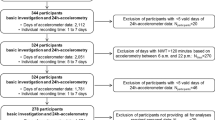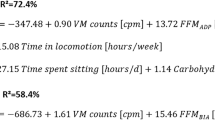Abstract
Objective: To determine the levels and patterns of daily physical activity in groups of normal-weight, overweight and obese adults using uniaxial minute-by-minute accelerometry.
Design: Cross-sectional study of physical activity levels over a 7 day period using accelerometers programmed to collect minute-by-minute data.
Setting: Participants were recruited from large companies in Bristol and Cardiff. All meetings took place on company premises.
Participants: One-hundred and eight participants volunteered for the study. Eighty-four (36 males, 48 females; 38.6±9.3 y) (mean±s.d.) met the inclusion criteria for accelerometer measurements and were included in analyses.
Results: No significant differences in physical activity were identified between normal-weight (BMI<25) and overweight (BMI 25–29.9) participants. Obese participants (BMI>30) were significantly less active than non-obese participants (BMI≤30) during weekdays (279.1±77.5 vs 391.3±139.4 counts min−1; P<0.001), weekends (222.3±93.9 vs 386.2±177.5 counts min−1; P<0.001) and evenings (221.1±126.3 vs 380.8±220.7 counts min−1; P=0.002), but not at work (307.5±87.2 vs 398.7±163.3 counts min−1; P=0.06). Differences in activity levels between obese and non-obese participants were greater in males than females. Hour-by-hour physical activity patterns demonstrated that obese participants were less active than the non-obese for almost every hour of the weekdays and the weekend.
Conclusions: Although no differences in activity emerged between overweight and normal-weight individuals, obese participants were substantially less active than the non-obese, particularly when there was a free choice of activity or no activity. The difference in activity levels was particularly pronounced in males, and unless obese individuals are compensating by lower energy intake, these activity patterns will contribute to the maintenance of or increase in the degree of obesity. Minute-by-minute accelerometry is a valuable tool for the assessment of activity patterns and may be useful to highlight periods of inactivity for intervention design.
Sponsorship: Health Promotion Wales.
European Journal of Clinical Nutrition (2000) 54, 887–894
This is a preview of subscription content, access via your institution
Access options
Subscribe to this journal
Receive 12 print issues and online access
$259.00 per year
only $21.58 per issue
Buy this article
- Purchase on Springer Link
- Instant access to full article PDF
Prices may be subject to local taxes which are calculated during checkout
Similar content being viewed by others
Author information
Authors and Affiliations
Contributions
Guarantor: AR Cooper.
Contributors: ARC was study originator and director, responsible for interpretation of data and preparation of the manuscript. AP was also study originator and director, responsible for interpretation of data, preparation of the manuscript. KRF was involved in interpretation of data, and preparation of the manuscript. JM was involved in data collection and entry, and preparation of the manuscript.
Corresponding author
Rights and permissions
About this article
Cite this article
Cooper, A., Page, A., Fox, K. et al. Physical activity patterns in normal, overweight and obese individuals using minute-by-minute accelerometry. Eur J Clin Nutr 54, 887–894 (2000). https://doi.org/10.1038/sj.ejcn.1601116
Received:
Revised:
Accepted:
Published:
Issue Date:
DOI: https://doi.org/10.1038/sj.ejcn.1601116
Keywords
This article is cited by
-
A systematic review of smartphone-based human activity recognition methods for health research
npj Digital Medicine (2021)
-
Impact of a group-based intervention program on physical activity and health-related outcomes in worksite settings
BMC Public Health (2020)
-
Seasonality of physical activity and its association with socioeconomic and health factors among urban-dwelling adults of Kaunas, Lithuania
BMC Public Health (2019)
-
Physical activity is related to function and fatigue but not pain in women with fibromyalgia: baseline analyses from the Fibromyalgia Activity Study with TENS (FAST)
Arthritis Research & Therapy (2018)
-
Health enhancing physical activity in patients with hip or knee osteoarthritis - an observational intervention study
BMC Musculoskeletal Disorders (2017)



